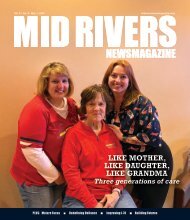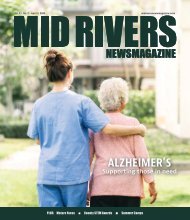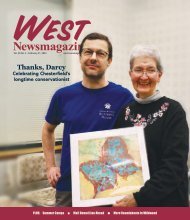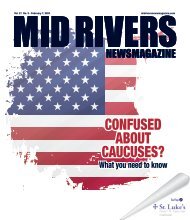Mid Rivers Newsmagazine 11-18-20
Local news, local politics and community events for St. Charles County Missouri.
Local news, local politics and community events for St. Charles County Missouri.
Create successful ePaper yourself
Turn your PDF publications into a flip-book with our unique Google optimized e-Paper software.
26 I HEALTH I<br />
November <strong>18</strong>, <strong>20</strong><strong>20</strong><br />
MID RIVERS NEWSMAGAZINE<br />
@MIDRIVERSNEWS<br />
MIDRIVERSNEWSMAGAZINE.COM<br />
Thanksgiving and other holiday gatherings will likely look different this year<br />
– and many may not happen at all – due to the pandemic. (Source: Adobe Stock)<br />
health<br />
capsules<br />
By LISA RUSSELL<br />
It’s finally time to celebrate the<br />
holidays together … or not<br />
The Centers for Disease Control and Prevention<br />
recently poured cold water on the<br />
Thanksgiving plans of many families, warning<br />
that holding even small holiday celebrations<br />
with loved ones may put Americans at<br />
increased risk for contracting COVID-19.<br />
Dr. Anthony Fauci, director of the<br />
National Institute of Allergy and Infectious<br />
Diseases and now-controversial White<br />
House advisor, backed up that warning with<br />
a public announcement that his own children<br />
won’t be coming home for Thanksgiving<br />
this year because of the risk. “You<br />
may have to bite the bullet and sacrifice that<br />
social gathering,” Fauci advised as cases of<br />
the virus continue to spike in many areas …<br />
including Missouri, where hospitalizations<br />
and deaths hit a new record in October.<br />
However, deciding whether to host or<br />
attend a particular Thanksgiving celebration<br />
or other holiday gathering remains in<br />
the hands of each individual and family.<br />
Following are guidelines the CDC has provided<br />
to help people make those decisions.<br />
• Number of people at the gathering –<br />
Gatherings with more people pose more<br />
risk than gatherings with a few, although<br />
the CDC does not have a limit or recommend<br />
a specific number of attendees.<br />
Instead, the size of a holiday gathering<br />
should be determined based on the ability<br />
to reduce or limit contact and virus spread<br />
between attendees along with state and<br />
local safety regulations.<br />
• Food and drinks – Self-serve bars or<br />
meals served buffet style pose more risk to<br />
attendees.<br />
• Community levels of COVID-19 –<br />
Family and friends should consider the<br />
number and rate of COVID-19 cases in<br />
their own community and, just as importantly,<br />
in the communities their guests are<br />
coming from.<br />
• The location and duration of the gathering<br />
– Indoor gatherings generally pose<br />
more risk than outdoor gatherings – for<br />
indoor gatherings, keeping windows and<br />
doors open to increase ventilation can help<br />
to decrease risk. Gatherings that last several<br />
hours also pose more risk than shorter ones.<br />
• The behaviors of guests prior to the<br />
gathering – People who are generally not<br />
adhering to social distancing, mask wearing,<br />
hand washing, and other preventive<br />
behaviors pose more risk and should<br />
potentially be left off the guest list, as<br />
should those who refuse to follow these<br />
behavior rules during the gathering.<br />
Everyday habit may reduce<br />
household COVID-19 spread<br />
A large percentage of COVID-19 cases<br />
to date have been due to the virus spreading<br />
among family members or others living in<br />
the same household … with a transmission<br />
rate as high as 50% in some studies. But<br />
taking the simple step of using mouthwash<br />
or another oral antiseptic on a daily basis<br />
may help to contain the spread by inactivating<br />
the virus in the mouth and throat,<br />
Penn State scientists have discovered.<br />
A group of doctors and scientists at the<br />
university’s College of Medicine tested<br />
several different types of oral and nasopharyngeal<br />
(nose and throat) products in a lab<br />
for their ability to inactivate human coronaviruses<br />
similar in structure to SARS-<br />
CoV-2, the virus that causes COVID-19.<br />
The products included various brands<br />
of mouthwash, peroxide-based antiseptic<br />
mouth rinses, a 1% solution of baby shampoo,<br />
and a neti pot. They allowed these<br />
solutions to interact with the viruses for<br />
periods of 30 seconds, one minute and two<br />
minutes before diluting them to prevent<br />
further virus inactivation.<br />
They found that many of the mouthwash<br />
and oral rinse products effectively inactivated<br />
greater than 99.9% of the infectious<br />
virus after only 30 seconds of contact time,<br />
while others took longer but also did so.<br />
The 1% baby shampoo solution – which is<br />
often used by head and neck specialists to<br />
rinse the sinuses of patients – inactivated<br />
Regular use of mouthwash/oral antiseptic<br />
products may limit the spread of COVID-19<br />
within households. (Source: Adobe Stock)<br />
more than 99.9% of the virus after two<br />
minutes of contact.<br />
The team said that while more specific<br />
studies are needed, these products may<br />
have real potential to reduce the amount<br />
of virus spread by people who are positive<br />
for COVID-19, especially inside their own<br />
homes.<br />
New FDA guidelines warn about<br />
NSAID use during pregnancy<br />
In mid-October, the U.S. Food and Drug<br />
Administration announced new labeling<br />
requirements for all prescription and overthe-counter<br />
nonsteroidal anti-inflammatory<br />
drugs (NSAIDs). These changes will<br />
include warnings that if taken after about<br />
<strong>20</strong> weeks of pregnancy, the drugs can<br />
cause rare but serious kidney problems in<br />
unborn babies which can lead to low levels<br />
of amniotic fluid, which is essential for<br />
their protection in the womb.<br />
NSAIDs include medicines such as<br />
ibuprofen, naproxen, diclofenac, and celecoxib.<br />
While aspirin also is an NSAID, the<br />
new recommendations do not apply to the<br />
use of low-dose aspirin (81 mg), which is<br />
an important treatment for some women<br />
during pregnancy.<br />
At about the <strong>20</strong>-week mark, an unborn<br />
baby’s kidneys begin producing most of<br />
the amniotic fluid that surrounds it. In some<br />
cases, fetal kidney problems and lowered<br />
amniotic fluid levels have been detected<br />
after as little as two days of maternal NSAID<br />
use. The condition usually goes away if the<br />
mother stops taking the NSAID.<br />
Many Americans receive ‘surprise’<br />
bills for colonoscopy expenses<br />
Having regular colonoscopy screenings<br />
is known to be the most effective way to<br />
prevent colorectal cancer. Current federal<br />
regulations require coverage of those<br />
screenings as preventive care – meaning<br />
that commercially insured patients should<br />
pay nothing as long as their colonoscopies<br />
are performed by providers that participate<br />
in the medical insurer’s network.<br />
For that reason, Americans who are covered<br />
under their employers’ medical plans<br />
and use the plans’ in-network providers

















